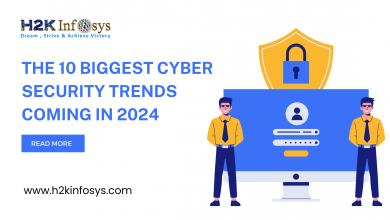Securing Your Digital Footprint- Simple Steps to Cyber Safety

The phrase “digital footprint” is probably familiar to you, but you might not know exactly what it means or how to best manage your online presence for increased protection and privacy. It’s crucial to understand these topics in our increasingly digital environment, so let’s go over the basics. Check out the cyber security course online to learn more.
What is a Digital Footprint?
Your whole internet history is compiled into your digital footprint. Consider your daily routine: updating your social media, buying something, setting up an account, signing up for a newsletter, checking the weather, filling out a survey, or sharing an article.
Every action you take creates a digital trail that may contain your IP address and whatever private information you’ve disclosed online about yourself. (An IP address is a distinct set of digits given to every device connected to the internet. Your name, mailing address, or phone number are not displayed; just the city, area code, or ZIP code from where you’re connecting may be seen.) Marketers, credit card companies, advertising, law enforcement, and other groups may follow and analyse this data to get insight into your spending patterns and build personalised profiles.
To put it succinctly, your digital footprint is like the tracks you make when strolling across newly fallen snow. Your whereabouts will be visible to others. Furthermore, digital footprints can last a lifetime, whereas snow tracks eventually disappear.
Digital Footprints: The Good and Bad
Digital footprints have several advantages. By offering a more tailored and easy experience, they can improve the time you spend online. For example, they might recall your most recent meal order or send you unique, exclusive offers based on your interests.
Through the messages, images, and other content you post on social media and other online platforms, you may even help shape the “positive” impression of yourself that you might want to leave online for people you want to impress, like your boss, potential employers, or college admissions officers.
However, there are a number of drawbacks to having a digital footprint, including identity theft, diminished privacy, and unsolicited solicitations. Cybercriminals can exploit your digital footprint to launch more focused and successful social engineering operations against you, including phishing attacks and other scams.
1.Search for yourself
Searching for yourself online could come across as a little conceited. However, it’s a useful approach to evaluate what kind of information about you is easily accessible. Investigate the first few pages of results by trying this with several search engines.
However, be ready to be taken aback by what you find. It might be unsettling. Please get in touch with the site administrator to ask that any personal information that you would like to keep private be removed, as well as any information that is inaccurate, deceptive, or inappropriate.
2.Set alerts
Consider creating notifications after your search to make it easier to follow up on your internet mentions later on. You can set up an alert to get notified every time your name appears online.
You can add terms related to you (like your hometown) to your search to help weed out results from other people with your name.
3.Use tighter privacy settings
Users of social media, e-commerce, email, search engines, web browsers, online conferencing, and other services frequently have the option to control their account privacy settings.
Reducing your digital footprint can be achieved by using more restricted settings. Direct links to the National Cybersecurity Alliance’s privacy settings management page are available for several well-known websites.
However, be advised that enhancing your security may cause other issues or interfere with the site’s usability in some way. For instance, it could be more difficult to do searches in the future if you delete your search history. You can also miss out on deals or advertisements that you would otherwise find welcoming if you disable pop-up adverts. Even if the advantages of increased privacy frequently outweigh these compromises, you should be aware of the consequences of your actions before making any changes.
Spend a few minutes reading the company’s privacy policy in addition to changing your privacy settings. It’s critical to comprehend how a company gathers, maintains, safeguards, and uses your personal information. It’s better to disregard a policy if you think it encroaches too much. Your security and privacy are very important.
4.Be cautious with social media
You should still use caution when deciding what personal information you choose to disclose online, even if you have more stringent privacy settings. For instance, be cautious while answering questionnaires on social media because they may divulge private information.
Alternatively, you may wish to proudly share a photo of your new grandchild on social media. However, keep in mind that whatever you post online could be reposted without your permission by friends, family, and coworkers. After that, you have no control over who sees the information you provide.
5.Restrict mobile app permissions
A mobile app owner gains access to your data if you allow them to access your contacts, camera, location, images, and other data. Thus, exercise caution before granting an app access to every kind of data it asks for. Remember that many programs can function even without full permissions being given.
6.Limit your online accounts
An increased number of online accounts results in a bigger footprint. However, by removing or deactivating accounts you no longer use, you can swiftly lessen your environmental impact. For instance, is having multiple email accounts required? And what about the online retailer account you opened three years ago, which you haven’t used since?
When creating new accounts, exercise caution as well. Unless you want to be a frequent customer, it is preferable to use the option to check out as a guest with a merchant rather than creating an account.
7.Use a password manager
A password manager is a piece of software that generates, encrypts, and safely keeps secure passwords for you. It also spares you the trouble of having to remember multiple passwords, as each account should have a unique password.
For any accounts where it is available, turn on multi-factor authentication (also known as two-factor authentication).
8.Think before linking accounts
Certain service providers let you sign up with them using an account you already have with another firm. For example, you might receive an invitation to log in using your Google or Facebook account.
You’ll need to assess if the convenience justifies the possible increased exposure, as doing so gives these other businesses access to even more details about your internet actions.
Conclusion
In conclusion, cybercriminals can launch targeted attacks and scams using your “digital footprint,” which is the culmination of all your online activity. By conducting a self-search, configuring warnings, and adjusting your privacy settings, you may lessen the potentially harmful effects of your online presence. Lastly, keep in mind to utilise a password manager, limit mobile app access, and exercise caution when using social media. Check out the cyber security training online to learn more.





